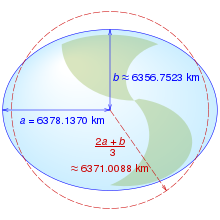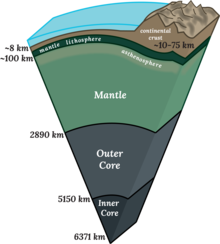
Back Aardradius Afrikaans نصف قطر الأرض Arabic Земен радиус Bulgarian পৃথিবীর ব্যাসার্ধ Bengali/Bangla Radi de la Terra Catalan Erdradius German Râǵ edla Tèra EML Tera radiuso Esperanto Radio terrestre Spanish شعاع زمین Persian
| Earth radius | |
|---|---|
 Equatorial (a), polar (b) and arithmetic mean Earth radii as defined in the 1984 World Geodetic System revision (not to scale) | |
Other names | terrestrial radius |
Common symbols | R🜨, RE, a, b, aE, bE, ReE, RpE |
| SI unit | meters |
| In SI base units | m |
Behaviour under coord transformation | scalar |
| Dimension | |
| Value | Equatorial radius: a = (6378137.0 m) Polar radius: b = (6356752.3 m) |
| Nominal Earth radius | |
|---|---|
 Cross section of Earth's Interior | |
| General information | |
| Unit system | astronomy, geophysics |
| Unit of | distance |
| Symbol | , , |
| Conversions | |
| 1 in ... | ... is equal to ... |
| SI base unit | 6.3781×106 m[1] |
| Metric system | 6,357 to 6,378 km |
| English units | 3,950 to 3,963 mi |
| Geodesy |
|---|
 |
Earth radius (denoted as R🜨 or RE) is the distance from the center of Earth to a point on or near its surface. Approximating the figure of Earth by an Earth spheroid (an oblate ellipsoid), the radius ranges from a maximum (equatorial radius, denoted a) of nearly 6,378 km (3,963 mi) to a minimum (polar radius, denoted b) of nearly 6,357 km (3,950 mi).
A globally-average value is usually considered to be 6,371 kilometres (3,959 mi) with a 0.3% variability (±10 km) for the following reasons. The International Union of Geodesy and Geophysics (IUGG) provides three reference values: the mean radius (R1) of three radii measured at two equator points and a pole; the authalic radius, which is the radius of a sphere with the same surface area (R2); and the volumetric radius, which is the radius of a sphere having the same volume as the ellipsoid (R3).[2] All three values are about 6,371 kilometres (3,959 mi).
Other ways to define and measure the Earth's radius involve either the spheroid's radius of curvature or the actual topography. A few definitions yield values outside the range between the polar radius and equatorial radius because they account for localized effects.
A nominal Earth radius (denoted ) is sometimes used as a unit of measurement in astronomy and geophysics, a conversion factor used when expressing planetary properties as multiples or fractions of a constant terrestrial radius; if the choice between equatorial or polar radii is not explicit, the equatorial radius is to be assumed, as recommended by the International Astronomical Union (IAU).[1]
- ^ a b Mamajek, E. E; Prsa, A; Torres, G; et al. (2015). "IAU 2015 Resolution B3 on Recommended Nominal Conversion Constants for Selected Solar and Planetary Properties". arXiv:1510.07674 [astro-ph.SR].
- ^ Cite error: The named reference
Moritzwas invoked but never defined (see the help page).



